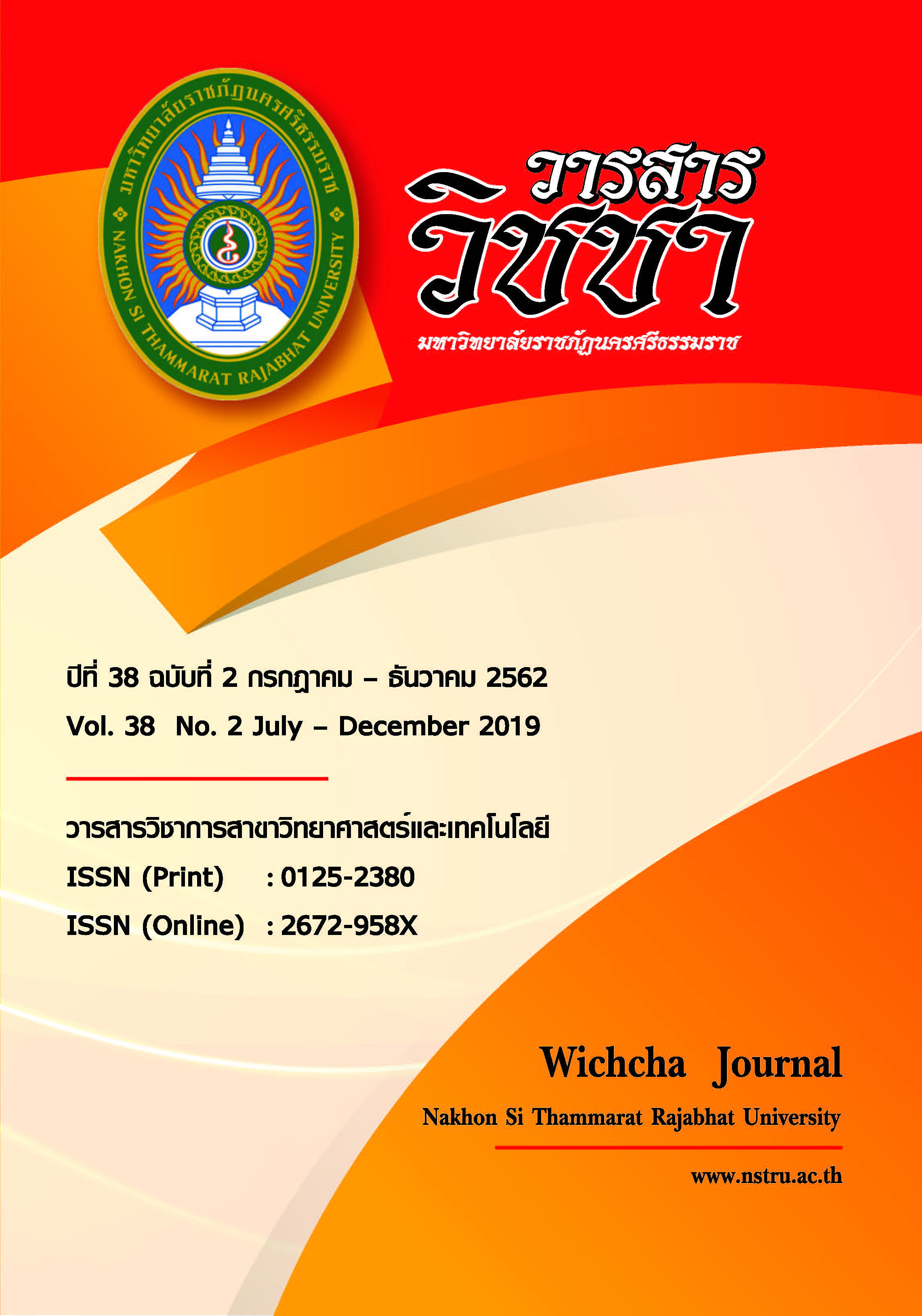Effects of Thai sticky rice varieties on rancidity and sensory acceptability of Plaa-Som ผลของพันธุ์ข้าวเหนียวไทยต่อการเกิดกลิ่นหืนและการยอมรับของปลาส้ม
Main Article Content
Abstract
This research was purposed to study the chemical compositions of five Thai sticky rice cultivars including “Gorkhor 6” (RD 6), “Sanpathong”, “Dang”, “Laotak” and “Whan 1” on product rancidity during fermentation at 35°C for 3 days and consumer acceptability of Plaa-Som. The results showed that all sticky rice cultivars contained significantly different contents of chemical composition (p ≤ 0.05), in particular “Dang” sticky rice which displayed to have significant higher in crude fat, mineral, total phenolic compounds, total anthocyanins and antioxidant activity than other rice (p ≤ 0.05). From the results of TBA (Thiobarbituric acid) values, Plaa-Som fermented with “Dang” sticky rice showed the lowest in rancidity value (p ≤ 0.05). Nevertheless, the results of sensory evaluation showed that the overall liking scores of the sample attributes had no significant difference between uncooked and fried Plaa-Som.
Article Details
เนื้อหาและข้อมูลในบทความที่ลงตีพิมพ์ในวารสารวิชชา มหาวิทยาลัยราชภัฏนครศรีธรรมราช ถือเป็นข้อคิดเห็นและความรับผิดชอบของผู้เขียนบทความโดยตรง ซึ่งกองบรรณาธิการวารสารไม่จำเป็นต้องเห็นด้วยหรือร่วมรับผิดชอบใด ๆ
บทความ ข้อมูล เนื้อหา รูปภาพ ฯลฯ ที่ได้รับการตีพิมพ์ในวารสารวิชชา มหาวิทยาลัยราชภัฏนครศรีธรรมราช ถือเป็นลิขสิทธ์ของวารสารวิชชา มหาวิทยาลัยราชภัฏนครศรีธรรมราช หากบุคคลหรือหน่วยงานใดต้องการนำข้อมูลทั้งหมดหรือส่วนหนึ่งส่วนใดไปเผยแพร่ต่อหรือเพื่อการกระทำการใด ๆ จะต้องได้รับอนุญาตเป็นลายลักษณ์อักษรจากวารสารวิชชา มหาวิทยาลัยราชภัฏนครศรีธรรมราชก่อนเท่านั้น
The content and information in the article published in Wichcha journal Nakhon Si Thammarat Rajabhat University, It is the opinion and responsibility of the author of the article. The editorial journals do not need to agree. Or share any responsibility.
References
พิทยา ใจคำ ณัฐธยาน์ บัวอุย และแดนชัย เครื่องเงิน. (2560). คุณลักษณะบางประการของปลาส้มที่มีส่วนผสมของข้าวพื้นเมืองของไทยสายพันธุ์ต่าง ๆ . สักทอง: วารสารวิทยาศาสตร์และเทคโนโลยี (สทวท.), 4(2), 23-34.
พิทยา ใจคำ และรัชนี แก้วจินดา. (2560). การเปลี่ยนแปลงคุณภาพของปลาส้มในระหว่างการหมักร่วม กับโพรไบโอติก Lactobacillus casei 01 ที่ระดับแตกต่างกัน. วารสารวิจัยและพัฒนา วไลยอลงกรณ์ ในพระบรมราชูปถัมภ์ สาขาวิทยาศาสตร์และเทคโนโลยี, 12(3), 37-53.
สำนักงานมาตรฐานผลิตภัณฑ์อุตสาหกรรม. (2557). มาตรฐานผลิตภัณฑ์ชุมชน “ปลาส้ม”: (มผช. 26/2557). กรุงเทพฯ: กระทรวงอุตสาหกรรม.
สิรินดา ยุ่นฉลาด สุกานดา วิชิตพันธุ์ งามนิจ นนทโส และพิกุลทอง ขอเพิ่มทรัพย์. (2548). การเปลี่ยนแปลงประชากรจุลินทรีย์และทางเคมีระหว่างกระบวนการหมักปลาส้มที่เป็นผลิตภัณฑ์ปลาหมักของไทย. วารสารวิจัย มข., 10(3), 188-198.
AOAC. (2000). Official Methods of Analysis of AOAC International. (17th ed). Maryland: Association of Official Analytical Chemists
Benzie, I.F.F. and Stain, J.J. (1996). The ferric reducing ability of plasma (FRAP) as a measure of antioxidant power; the FRAP assay. Analytical Biochemistry, 239, 70-76.
Chaikham, P., Prangthip, P. and Seesuriyachan, P. (2016). Ultra-sonication effects on quality attributes of maoberry (Antidesma bunius L.) juice. Food Science and Technology Research, 22(5), 647-654.
Hu, C. and Zawistowski, J. (2003). Black rice (Oryza sativa L. indica) pigmented fraction suppresses both reactive oxygen species and nitric oxide in chemical and biological model systems. Journal of Agricultural Food Chemistry, 51(18), 5271-5277.
Hu, Y., Xia, W. and Ge, C. (2008). Characterization of fermented silver carp sausages inoculated with mixed starter culture. LWT-Food Science and Technology, 41, 730-738.
Ichikawa, H. and Ichiyanagi, T. (2001). Antioxidant activity of anthocyanin extract from purple black rice. Journal of Medicine and Food, 4(4), 211-218.
Itani, T. and Ogawa, M. (2004). History and recent trends of red rice in Japan. Japanese Journal of Crop Science, 73(2), 137-147.
Medina, I., Sacchi, R., Biondi, L., Aubourg, S.P. and Paolillo, L. (1998). Effect of packing media on the oxidation of canned tuna lipids. Antioxidant effectiveness of extra virgin olive oil. Journal of Agricultural and Food Chemistry, 46(3), 1150-1157.
Naseri, M., Rezaei, M., Moieni, S., Hosseini, H. and Eskandari, S. (2011). Effects of different filling media on the oxidation and lipid quality of canned silver carp (Hypophthalmichthys molitrix). International Journal of Food Science and Technology, 46(6), 1149-1156.
Oko, A.O., Ubi, B.E., Efisue, A.A. and Dambaba, N. (2012). Comparative analysis of the chemical nutrient composition of selected local and newly introduced rice varieties grown in Ebonyi State of Nigeria. International Journal of Agriculture and Forestry, 2(2), 16-23.
Pengkumsri, N., Chaiyasut, C., Saenjum, C., Sirilun, S., Peerajan, S., Suwannalert, P., Sirisattha, S. and Sivamaruthi, B.A. (2015). Physicochemical and antioxidative properties of black, brown and red rice varieties of northern Thailand. Food Science and Technology (Campinas), 35(2), 331-338.
Sampels, S. (2013). Food Industry. Chapter 6 Oxidation and antioxidants in fish and meat fromfarmtofork.Retrieved18February2018,from:https://www.intechopen.com/books/food-industry/oxidation-and-antioxidants-in-fish-and-meat-from-farm-to-fork.
Shen, Y., Jin, L., Xiao, P., Lu, Y. and Bao, J. (2009). Total phenolics, flavonoids, antioxidant capacity in rice grain and their relations to grain color, size and weight. Journal of Cereal Science, 49(1), 106-111.
Sompong, R., Siebenhandl-Ehn, S., Linsberger-Martin, G. and Berghofer, E. (2011). Physicochemical and antioxidative properties of red and black rice varieties from Thailand, China and Sri Lanka. Food Chemistry, 124, 132-140.
Verma, D.K. and Srivastav, P.P. (2017). Proximate composition, mineral content and fatty acids analyses of aromatic and non-aromatic Indian rice. Rice Science, 24(1), 21-31.

